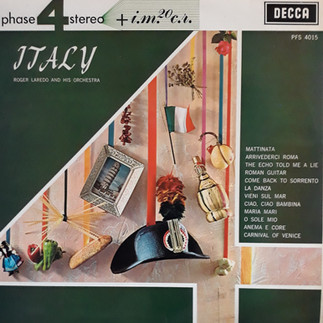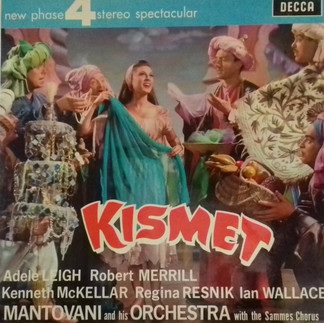PHASE 4 STEREO Post 1 Introduction
- The Cozooks of Brixham

- Feb 1, 2022
- 10 min read
Updated: Jul 24, 2022
This blog, like the WORLD OF one, refers largely to the UK series of the Phase 4 Stereo record series. Where I have them to show to you, however, I will include issues from other countries. Are you sitting comfortably? Then I'll begin!

Hmm, before I do, though ... I can't ignore the nagging thought that I need to do justice to a much-loved institution.
Listen with Mother was a radio programme on the BBC. The, pretty much, immortal line, ‘Are you sitting comfortably? Then I’ll begin’, which preceded the telling of the story, was first casually ad-libbed by Julia Lang, one of the many presenters over the 32+ year lifetime of the show, between 1950 to 1982. Julia Lang was an actress in film and on the radio. She appeared in six or so films back in 1948/49 and even played Ethel Pratt in a 1977 episode of Coronation Street. Lang also played the mother of Henry Gowan in a 1987 reworking of Dickens’ Little Dorrit but it is her spot on the early afternoon radio show Listen with Mother for which she is most well-known.
Apparently, Julia also, when she’d finished her story, had to make her way to the piano and play the closing theme tune, Fauré’s Berceuse from his ‘Dolly Suite’ … and then turn the lights off before she went home, too, I imagine!
So anyway, what is Phase 4 and what do those hieroglyphics which follow the aforementioned legend across the top of some of the earlier LPs of this series mean?
Before all that, though, did you even realise that there were first, second and third phases in the development of Phase 4 Stereo? Beginning in 1958, the first three phases were developed over the next three years until, in 1962, Phase 4 Stereo was born.
Phase 1 is simply the concept of stereo. Prior to this, mono sound reproduction did not allow for ‘live performance realism’, to quote the liner notes of the inside front of the gatefold cover of PFS 34002, ‘Pass in Review’. Now we could listen to a spread of sounds from left to right via the centre of two speakers. In the early days, these techniques were applied more to classical music employing full orchestras where certain sections could be separated from others.
Refinements enhanced the separation of sound during Phase 2 and whilst this further improved the listening experience for fans of classical music, this period is maybe more associated with the use of stereo to record sound effect noises and such as train engine sounds to bamboozle the listener by having the choo choo chuff chuffing from one speaker to the other.
Phase 3 refers to the period of discovery in the recording lab where the sound movement was made more sophisticated – individual members of a crowded orchestra could be isolated and moved during the performance right or left or, indeed, front or back in the final mix. This was particularly useful during opera where the singers’ voices could be tracked from speaker to speaker to replicate the characters’ movements across the stage as in the actual live performance.
Finally, Phase 4 involves the rescoring of music with a view to how its sound will ultimately be reproduced for the listener, using the skills developed in Phases 1, 2 and 3 to move the components to where, in the mix, they will be displayed to best use.
And then, there's Decca's explanation of Phase 4 Stereo: It is a "New Scoring Concepts Incorporating True Musical Use of Separation and Movement. In this phase, arrangers and orchestrators re-score the music to place the instruments where they are musically most desired at any particular moment and make use of direction and movement to punctuate the musicality of sounds. The effect is more sound - more interest - more entertainment - more participation - more listening pleasure: PHASE 4 STEREO is not background music." In 1964 the light classical Phase 4 Stereo "Concert Series" was created."
Used for the Decca and London labels throughout the Sixties, originally, Phase 4 recordings were made with a 10-channel mixer but this was soon boosted to a total of 20 channels, therefore, up to 20 individual instruments and/or voices or groups thereof. The sounds captured on these 20 channels were then converted to a four-track master which was then split and rebalanced down to a two-track tape, some of each track sent to either left or right speaker.
Clearly the above is a painfully simplified version but if you really need the full story, you could do worse than track down your own copy of PFS 34002. It can there be found laid out for those more technically gifted to understand.
There seems to be more than one theory as to how this system was called Phase ‘4’ but what else do you call a phase that follows numbers 1, 2 and 3?
Anyway, the proud boast of Decca at the time was that the 500,000th record produced would be identical in quality to the very first pressing.
The sound engineers involved with most of the records in the Phase 4 series were Arthurs Lilley and Bannister and it was they who oversaw the introduction of the ‘concert’ sub-series in 1964. These were the classical music records (including Richard Strauss' Also Sprach Zarathustra, The Planets by Holst and a Wagner Festival) whilst another sub-group was the Spectaculars. These were a bunch of LPs that, for one reason or another, were deemed worthy of special mention - records such as Werner Muller's Germany, New Rhythms of the South by Edmundo Ros and Roland Shaw's Westwood Ho! - yeee ha!
So, as well as LPs that have the legend ‘phase4stereo’ across the top from left, as is the case for the earlier records in the series, we also find ‘phase4stereo +i.m.20c.i.’, ‘phase4stereo spectacular’, ‘phase4stereo CONCERT SERIES’ or ...


... they may just have a box such as below:


They could even have ‘fases4estéreo’ if they are of Spanish origin and, of course, instead of the familiar box with ‘DECCA’ inside, we will find a box with ‘LONDON’ installed in the case of Canadian and US issues.

THE FRONT RECORD COVER
Apart from the ‘phase4stereo’ or the box above, there is no particular style or font to look out for except for the large cut-out-type number 4 that takes up most of the front cover of a bunch of the records in our collection.
Further, whereas the covers of THE WORLD OF (‘TWO’) LPs featured the word DECCA in a box, or DERAM,or MAM, or REX or ARGOS etc. the sleeves of Phase 4 Stereos (P4S) feature only DECCA or the LONDON logo for the Canadian issues, the latter of which, like the TWOs, are in thick card.
The photographs on the fronts are a real mixed bag. For example:
generic sample shots, .scenes from stage shows and historical prints.
THE BACK COVER
As with the TWO records, the back covers hold the catalogue numbers at top right but here there is no confusion as to whether they are mono or stereo, the clue being in the P4S name*. Also, the right-angled arrow pointing down the right side of the back cover taking your attention to the small print about how you can play your stereo LP on mono gear etc etc. features on only a few of the LPs.
*Actually, whilst the original idea for this series was for it to show off DECCA's brand new stereo system, it appears that the first twelve records (PFS 34001 to PFS 34012) were originally released as members of the SOUND 4 series in 1961, produced using the 'exciting' monophonic high fidelity technique, as it states on the back covers. That is, SOUND 4 mono records were mixed down to one track from four. However, this, understandably, failed to attract the attention of the record buying public and so was shelved ... not for long, though. It seems that the LPs were re-mixed top stereo and re-released as the (fanfare please) Phase 4 Stereos! Those more observant amongst you would notice that whilst the catalogue numbers for the majority of records in this collection feature the letters PFS followed by a four (4) and then the three figure number of the record, the first 12 have an extra 3 in front of the 4. And that ain't all - the covers of the original SOUND 4 series are different! Observe ... see how the first issue has an image inside each of two inward pointing arrow heads whilst the follow-up has one image in a big 4! Not to mention the addition of +i.m.20c.i. to the PHASE 4 STEREO Legend.




There are also changes to the text on the back cover, too. First of all, most obviously, in the opening paragraph, 'SOUND 4 mono-phonic' is replaced with 'PHASE 4 Stereo' and at the end of the introductory section, missing is a short paragraph extolling the virtues of the high fidelityness of this 'bright' record which is actually 'designed to make parties jollier'. The fun seems to have been extinguished during the modernisation process.
Next, after the writing credits in brackets beneath the song titles, there appears to be some sort of indication of ownership on the new record that wasn't there previously. For example, following the writers' names of track 1, 'Liechtensteiner Polka', (the order of which, incidentally, has been altered!) comes 'ABERBACH S.A. (PTY.) LTD.' which turns out to be a record label (of South African origin, I'm guessing since there does exist an ABERBACH AUSTRALIA etc. etc.) but then after 'Too Fat Polka' we find 'Francis Day & Hunter Ltd.' which appears to be the editors of a book of this name. And then some of the text describing the music of each track has changed in some cases. For instance, for the former tune above, the woodwinds used to 'predominate' but in the later description, they are 'markedly left' whereas ... blah de blah ... is heard on the right. For the latter, as for all of the others, actually, the PHASE 4ness is accentuated with 'left's' and 'right's peppered throughout.
And finally, the two images are shifted up a bit higher amongst the text and the picture of the detail of the front cover of the earlier LP, is now in colour.
OK, let's just finish off this back cover section ...
... There is generally more text providing information on the artists and the music than on TWO back covers.


THE INNER SLEEVE
As in the previous review, all inner sleeves are of paper which have central cut-outs through which the label can be viewed through a polythene liner.
You may remember from Post 2 of the TWO review that there were red-rimmed inners for mono records and blue for stereo. Well, we have no monos in this collection but we
do have blue-rimmed inner sleeves on some of the early LPs.
Some of the very early records are inserted into a different style of inner which wasn’t seen in the TWO series. They have a more old-fashioned appearance with the legend ‘Full Frequency Stereophonic Sound’ across the top of one side in an italic sort of joined-up writing but with a bold, blue upright capital at the head of each word accentuating the, by now, familiar ffss logo.
Beneath this are three lines of large print eschewing the advice on the back of some outer covers and claiming that ‘This record should be played only on equipment specifically designed or adapted for stereophonic records’, a message which is expanded upon in a dot-bordered box at bottom right with a headline of ‘PLAYING’ and beginning by drilling home the message that ‘This record must be played only on stereophonic equipment’, going on to tell us all the things that said equipment should include. Things such as a turntable revolving at a constant speed of 33⅓ rpm, a reproducing head of a weight which relates to the radius of the stylus and the mass of the pick-up tip etc. etc. They were clearly very protective of their new phase 4 invention.
At bottom left is a similarly designed box with a heading of ‘HANDLING’ followed by the usual list of instructions. Either side of the central cut out is a DECCA ffss logo and these feature on the other side, too, along with an in-depth explanation of that phenomenon. Running through phrases such as ‘entirely new’ and ‘highest definition’ it tells how the idea was to recreate the sound of a live orchestra in your own home.
Beneath the cut-out, there follows a brief reminder of past Decca glories with a few words on the ffrr system from pre stereo days. Full Frequency Range Recording was, Decca says, the finest, high fidelity monoaural recording system.
THE RECORD LABEL
In contrast to TWO’s ten or so different label designs, there is just one basic design associated with our PFS series.


The label is split horizontally with a line that brushes the top of the spindle hole, above which, the background colour is red whilst below, it is white. Curving around the top perimeter are either the usual copyright warning or the words ‘MADE IN ENGLAND/THE DECCA RECORD CO LTD.’ The version used depends upon which of the two DECCA logos are employed.
The more recognisable DECCA logo is the boxed one discussed above regarding the front cover. On the label, the box measures 35 x 16mm and features the word in white on a black background surrounded by a double thin white border along all four sides. It is this one with which the full copyright warning is associated.
The second DECCA is presented in simple black capitals, the whole word measuring 37 x 12mm on the red backing. This one features the more brief message around the top.
Canadian issues have the familiar LONDON imprint in place of the DECCA.

Whichever style of DECCA/LONDON logo, below it is a Phase 4 logo. This features the big 4 in white with the triangle of the top of the figure filled in black. Before this is the word ‘PHASE’, and ‘STEREO’ after, in small capitals also in white. The word ‘STEREO’ overlays a faded big 4 following which is another faded 4, following which, is a bold, black 4 with, in the case of the boxed DECCA, a thin white perimeter.
The lower half features, in one form or other, the LP title and artist in bold black sandwiching the track listing, the catalogue number and other usual bits and pieces, amongst which may be, in small black-bordered, attached, rectangles, BIEM and NCB.
The BIEM is the Bureau International de l'Edition Mécanique which is also known as the Bureau International des Sociétés Gérant les Droits d'Enregistrement et de Reproduction Mécanique. This is an organisation that coordinates various licencing agreements between countries and includes the control of music licencing. The BIEM, which is based in France, looks after artists (composers and publishers in the case of music) making sure that they receive due royalties and arbitrating in cases of disagreement.
Individual countries also have their own local organisations that work alongside the BIEM; the UK, for instance, has the MCPS (Mechanical-Copyright Protection Society). Amongst record labels of the 58 BIEM members (at time of writing) you may also find, for example, GEMA, which is the German version and SODRAC which is Canadian.
The NCB, that is, the Nordisk Copyright Bureau based in Denmark, does much the same for the rightsholders of the Scandinavian record companies, publishers, songwriters and lyricists.
Finally, for this introduction to Phase 4 Stereo, how about a bit of Fases 4 Estério. The LP below is the Spanish version of PFS 4016 – Dance Again by Edmundo Ros. Beside it is the UK issue.
You may notice yet another DECCA logo style here - the box is of slightly different dimensions than above (33 x 14mm) and the single white border is edged in black.
The last Phase 4 record was issued in 1979.
Any oversights and errors will be fixed as they are discovered
References available on request
Regarding the LP cover images, they are photographs of the records in my own collection and are taken by my own hand (which explains the slight wonkiness of some of them). All images should, however, be considered the property of Decca.
Any redistribution or reproduction of part or all of any image in any form is prohibited.
Any redistribution or reproduction of part or all of the text in any form is prohibited, restricted by permission of the author.


































Dear Cozooks,
An interesting read, as always, and your anorakial (is that a word? It is now!)level of knowledge is more than a little impressive. Decca would seem to have been ahead of EMI in their development of multi track recordings. If only George Martin had changed sides, what might The Beatles have achieved?
Right, now for a mind blowing stereo experience, but what’s it to be, Gershwin or Hawaiian Swing?
I